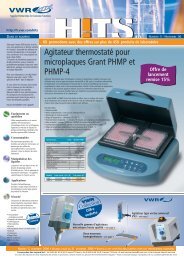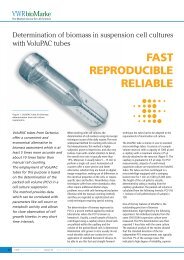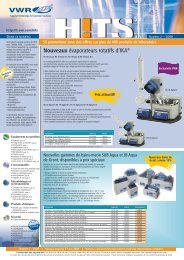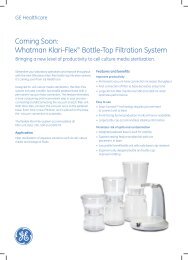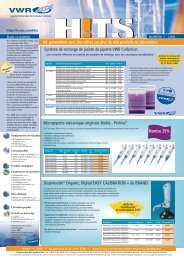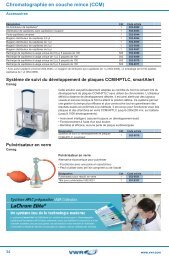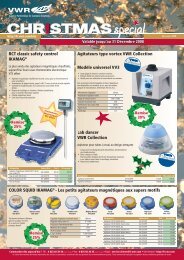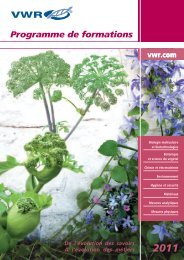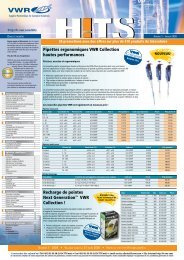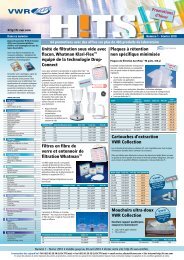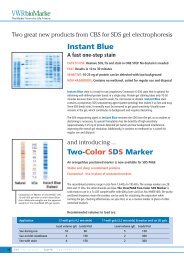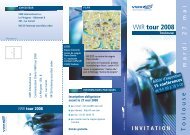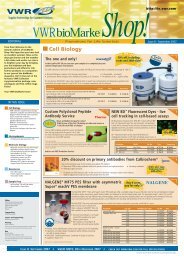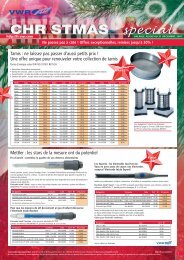Filter papers - a guide
Filter papers - a guide
Filter papers - a guide
You also want an ePaper? Increase the reach of your titles
YUMPU automatically turns print PDFs into web optimized ePapers that Google loves.
<strong>Filter</strong> <strong>papers</strong> - a <strong>guide</strong>Qualitative filter <strong>papers</strong> - standard gradewww.vwr.comThese cellulose filters are used in qualitative analytical techniques to determine and identify materials.Prepleated qualitative filters are also available, which give improved flow rate and increased loading capacitycompared to equivalent flat filters. In addition, Whatman offers a range of wet strengthened qualitativefilters that contain a small quantity of a chemically stable resin to give improved high wet strength. This doesnot introduce any significant impurities into the filtrate. The resin, however, does contain nitrogen so thesegrades should not be used in Kjeldahl estimations etc. All wet strengthened grades are available in prepleatedforms.Whatmanprovide an extensive range of qualitative filters to meet your specific needs :Grade 1: 11 μmThe most widely used filter paper forroutine applications with mediumretention and flow rate. This gradecovers a wide range of laboratoryapplications and is frequently usedfor clarifying liquids. Traditionally thegrade is used in qualitative analyticalseparations for precipitates such aslead sulphate, calcium oxalate (hot)and calcium carbonate. In agricultureit is used for soil analysis and seedtesting procedures. In the foodindustry, Grade 1 filters are usedfor numerous routine techniquesto separate solid foodstuffs fromassociated liquid or extracting liquidand is widely used in education forteaching simple qualitative analyticalseparations.Grade 2: 8 μmSlightly more retentive than Grade1 with a corresponding increase infiltration time (i.e. slightly slowerfiltration speed). More absorbentthan Grade 1. In addition to generalfiltration in the 8 μm particle sizerange, the extra absorbency is utilised,for example, to hold soil nutrient inplant growth trials.Grade 3: 6 μmDouble the thickness of Grade 1with still finer particle retention andexcellent loading capacity; moreprecipitate can be held withoutclogging. The extra thickness givesincreased wet strength and makesthis grade highly suitable for use inBüchner funnels. The high absorbencyis particularly valuable when thepaper is used as a sample carrier.Grade 4: 20 - 25 μmExtremely fast filtering with excellentretention of coarse particles andgelatinous precipitates such as ferrichydroxide and aluminum hydroxide.Very useful as a rapid filter for routineclean-up of biological fluids or organicextracts during analysis.Grade 5: 2.5 μmThe maximum degree of fineparticle filtration in the qualitativerange. Capable of retaining the fineprecipitates encountered in chemicalanalysis. Slow flow rate. Excellentclarifying filter for cloudy suspensionsand for water and soil analysis.Grade 6: 3 μmTwice as fast as Grade 5 with similarfine particle retention. Often specifiedfor boiler water analysis applications.Grade 595: 4 - 7 μmVery popular, thin filter paper, mediumfast with medium to fine particleretention. Used for many routineanalytical applications in differentindustries, (e.g., particle separationfrom food extracts or filtration ofsolids from digested environmentalsamples, e.g., for ICP/AAS analysis).Grade 597: 4 - 7 μmA medium fast filter paper withmedium to fine particle retention.Used for a wide variety of analyticalroutine applications in differentindustries like food testing(e.g. determination of fat content acc.to Section 35 LMBG*) or removal ofcarbon dioxide and turbidity frombeverages (e.g. beer analysis).Grade 598: 8 - 10 μmA thick filter paper with high loadingcapacity. Combines medium retentionwith medium fast to fast filtrationspeed.Grade 602 h:
Qualitative filter <strong>papers</strong> – wet strengthened gradesThese extremely strong filter <strong>papers</strong> have a high wet strength due to the addition of a smallquantity of chemically stable resin. Normal qualitative applications will not introduce anysignificant impurities into the filtrate. The resins do, however, contain nitrogen so these gradesshould not be used in Kjeldahl estimations, etc. Some wet strengthened grades are available infolded (prepleated) forms.Grade 91: 10 μmA general purposecreped filter for lesscritical routine analysis.Widely used to assaysucrose in cane sugar and withinpharmaceutical laboratories forroutine filtration.Grade 113: 30 μmUltra-high loading capacity with aparticle retention making it idealfor use with coarse or gelatinousprecipitates. Fastest flow rate ofthe qualitative grades. Crepedsurface. Thickest filter paper in theWhatman range.Grade 114: 25 μmOnly half the thickness of Grade 113and suitable for coarse or gelatinousprecipitates. Smooth surface for easyrecovery of precipitates.Grade 1573: 12 - 25 μmA fast filter paper with high wetstrength. It has a very smoothsurface making it easy to scrape orwash off precipitate.Grade 1575:
Quantitative filter <strong>papers</strong> – ashless grades (Ash 0.007%)Whatman quantitative filters are designed for gravimetric analysis and the preparation of samples forinstrumental analysis. They are available in three formats designed to meet your specific needs.• Ashless: 0.007% ash maximum for grades 40 to 44 and a maximum of 0.01% for 589 grades – very purefilters ideal for a wide range of critical analytical filtration procedures• Hardened low ash: 0.015% ash maximum – treated with a strong acid to remove trace metals andproduce high wet strength and chemical resistance; these filters are particularly suitable for Büchnerfiltration where the tough smooth surface of the filter makes it easy to recover precipitates• Hardened ashless: 0.006% ash maximum – acid hardened to give high wet strength and chemicalresistance with extremely low ash content; the tough surface makes these filters suitable for a widerange of critical filtration proceduresGrade 40: 8 μmThe classic general purpose ashlessfilter paper with medium speedand retention. Typical applicationsinclude gravimetric analysis fornumerous components in cements,clays, iron and steel products; as aprimary filter for separating solidmatter from aqueous extracts ingeneral soil analysis, quantitativedetermination of sediments in milkand as a pure analytical gradeclean-up filter for solutions priorto AA spectrometry. Used also as ahigh purity filter in the collection oftrace elements and radionuclidesfrom the atmosphere.Grade 41: 20 - 25 μmThe fastest ashless filter paper,recommended for analyticalprocedures involving coarseparticles or gelatinous precipitates(e.g. iron or aluminum hydroxides).Also used in quantitative airpollution analysis as a paper tapefor impregnation when determininggaseous compounds at high flowrates.Grade 42: 2.5 μmA world standard for criticalgravimetric analysis with the finestparticle retention of all Whatmancellulose filter <strong>papers</strong>. Typicalanalytical precipitates includebarium sulphate, metastannic acidand finely precipitated calciumcarbonate.Grade 43: 16 μmIntermediate in retentionbetween Grades 40 and 41,and twice as fast as Grade 40.Typical applications includefoodstuffs analysis; soil analysis;particle collection in air pollutionmonitoring for subsequent analysisby XRF techniques; and inorganicanalysis in the construction, miningand steel industries.Grade 44: 3 μmThin version of Grade 42 retainingvery fine particles but with lowerash weight per sample and almosttwice the flow rate of Grade 42.Grade 589/1: 12 - 25 μm‘Black Ribbon <strong>Filter</strong>’ – theestablished standard inquantitative analysis for thefiltration of coarse precipitates(Class 2a acc. to DIN 53 135).Ashless filter paper with veryhigh flow rate. Used for manyquantitative standard methods,especially for gravimetricapplications (e.g. determination ofthe ash content in foodstuffs acc.to Section 35 LMBG*), or for theBlaine test in the cement industry.Grade 589/2: 4 - 12 μm‘White Ribbon <strong>Filter</strong>’ – ashlessstandard filter paper for mediumfine precipitates (Class 2b acc.to DIN 53 135) offering mediumfiltration speeds. Applied ina variety of routine methodsin quantitative analysis, e.g.determination of the sand contentin foodstuffs acc. to Section 35LMBG*; determination of the gradeof flour; or analysis of aqueoussuspensions in the paper industry.Grade 589/3: 2 μm‘Blue Ribbon <strong>Filter</strong>’ – ashlessstandard filter paper for very fineprecipitates (Class 2d acc. to DIN53 135). Slow filter paper withhighest efficiency for collectingvery small particles. Also used formany analytical routine methodsin different industries, e.g.determination of the amount ofinsoluble contaminants in animaland vegetable fats and oils acc. toSection 35 LBMG*.Do you use the best filter for your filtration step?Do you want an improved flow or better retention?Try our filter selector!Free samples available : Go to http://eu.vwr.com/whatmanwww.vwr.comVWR International – <strong>Filter</strong> <strong>papers</strong> - a <strong>guide</strong>3
Quantitative filter <strong>papers</strong> – hardened low ash gradesThe maximum ash content of these grades is intermediate between ashless and qualitative.They are particularly suitable for Büchner filtrations where it is desirable to recover theprecipitate from the filter surface after filtration. Other characteristics include high wetstrength and chemical resistance which are similar to the acid hardened ashless filter<strong>papers</strong>.Grade 50: 2.7 μmRetention of finest crystallineprecipitates. The thinnest of allWhatman filter <strong>papers</strong>. Slow flowrate. Hardened and highly glazedsurface. This finish also keeps thepaper free from loose surface fibres.Highly suitable for qualitative orquantitative filtrations requiringvacuum assistance on Büchner or 3 piece filter funnels.Very strong when wet. Will withstand wet handlingand precipitate removal by scraping. In the electronicsindustry, the virtual absence of fibre shedding isutilised in carriers for integrated circuits.Grade 52: 7 μmThe general purpose hardened filter paper withmedium retention and flow rate. Very hard surface.Grade 54: 20 - 25 μmVery fast filtration for use with coarse and gelatinousprecipitates. High wet strength makes this grade verysuitable for vacuum assisted fast filtration of ‘difficult’coarse or gelatinous precipitates.Quantitative filter <strong>papers</strong> – hardened ashless gradesThese are the supreme quantitative filter <strong>papers</strong> featuring high wet strength andchemical resistance. These <strong>papers</strong> are acid hardened, which reduces ash to anextremely low level. Their tough surfaces make them suitable for a wide range ofcritical analytical filtration operations. Each grade offers a convenient combination offiltration speed and particle retention.Grade 540: 8 μmThe general purpose hardenedashless filter paper withmedium retention and flow rate.Extremely pure and strong witha hard surface. High chemicalresistance to strong acid andalkali. Frequently used in thegravimetric analysis of metals in acid/alkali solutionsand in collecting hydroxides after precipitation bystrong alkalis.Grade 541: 20 - 25 μmFast filtration of coarse particles and gelatinousprecipitates in acid/alkali solutions during gravimetricanalysis. Typical applications include fibre in animalfoodstuffs, gelatine in milk and cream, chloride incement, and chloride and phosphorous in coal andcoke.Grade 542: 2.7 μmHigh retention of fine particles under demandingconditions. Slow flow rate. Very hard and strong withexcellent chemical resistance. Often used in gravimetricmetal determinations.Your European Distribution PartnerBelgiumVWR International bvbaResearchpark Haasrode 2020Geldenaaksebaan 4643001 LeuvenTel.: 016 385 011Fax: 016 385 385E-mail: customerservice@be.vwr.comDenmarkVWR - Bie & BerntsenTransformervej 82730 HerlevTel.: 43 86 87 88Fax: 43 86 87 90E-mail: info@dk.vwr.comFinlandVWR International OyValimotie 900380 HelsinkiTel.: 09 80 45 51Fax: 09 80 45 52 00E-mail: info@fi.vwr.comHungaryVWR Spektrum-3D Kft.Simon László u. 4.4034 DebrecenTel.: (52) 521 131Fax: (52) 470 069E-mail: info@spektrum-3d.huIreland/Northern IrelandVWR International Ltd./VWR International(Northern Ireland) Ltd.Orion Business CampusNorthwest Business ParkBallycoolin - Dublin 15 - IrelandTel.: 01 88 22 222Fax: 01 88 22 333E-mail: sales@ie.vwr.comThe NetherlandsVWR International B.V.Postbus 81981005 AD AmsterdamTel.: 020 4808 400Fax: 020 4808 480E-mail: info@nl.vwr.comNorwayVWR International ASHaavard Martinsens vei 300978 OsloTel.: 0 2290Fax: 815 00 940E-mail: info@no.vwr.comPolandLabart Sp. z o.o.A VWR International CompanyLimbowa 580-175 GdanskTel.: 058 32 38 2 10Fax: 058 32 38 205E-mail: labart@labart.plSwedenVWR International ABFagerstagatan 18a163 94 StockholmTel.: 08 621 34 00Fax: 08 621 34 66E-mail: info@se.vwr.comUKVWR International LtdCustomer Service CentreHunter BoulevardMagna Park - LutterworthLeicestershire - LE17 4XNTel.: 0800 22 33 44Fax: 01455 55 85 86E-mail: uksales@uk.vwr.commb em 06 20114 VWR International – <strong>Filter</strong> <strong>papers</strong> - a <strong>guide</strong> www.vwr.com



